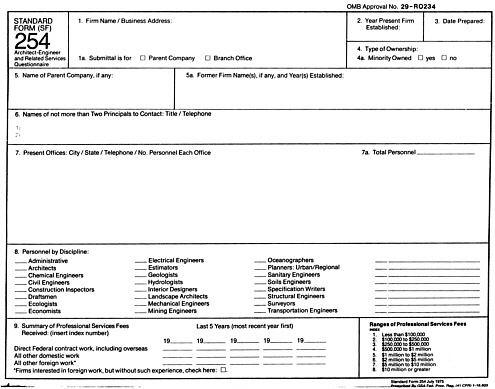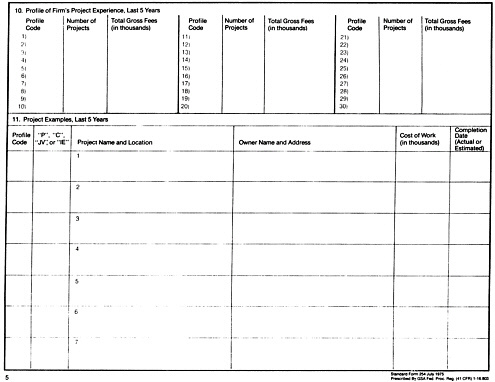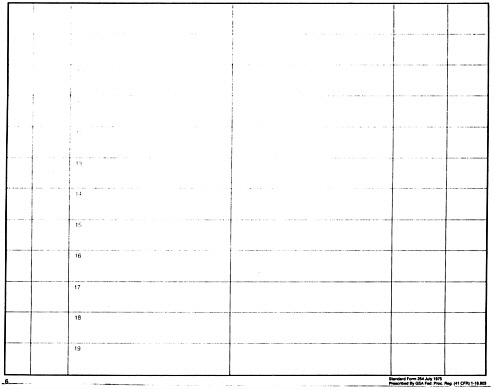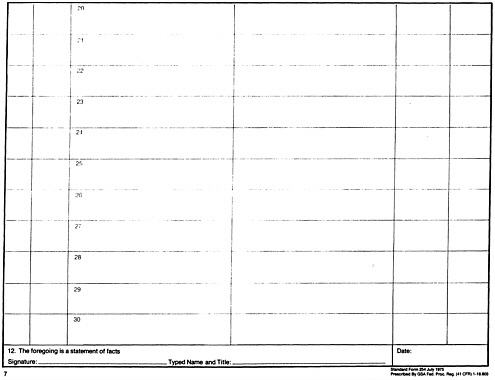STANDARD FORM (SF) 254
Architect-Engineer and Related Services Questinnaire
Standard Form 254
General Services Administration,
Washington, D.C. 20405
Fed. Proc. Reg. (41 CFR) 1–16.803
Armed Svc. Proc. Reg. 18–403
Purpose:
The policy of the Federal Government, in procuring architectural, engineering, and related professional services, is to encourage firms lawfully engaged in the practice of those professions to submit annually a statement of qualifications and performance data. Standard Form 254, “Architect-Engineer and Related Services Questionnaire” is provided for that purpose. Interested A-E firms (including new, small, and/or minority firms) should complete and file SF 254’s with each Federal agency and with appropriate regional or district offices for which the A-E is qualified to perform services. The agency head for each proposed project shall evaluate these qualification resumes, together with any other performance data on file or requested by the agency, in relation to the proposed project. The SF 254 may be used as a basis for selecting firms for discussions, or for screening firms preliminary to inviting submission of additional information.
Definitions:
“Architect-engineer and related service” are those professional services associated with research, development, design and construction, alteration, or repair of real property, as well as incidental services that members of these professions and those in their employ may logically or justifiably perform, including studies, investigations, surveys, evaluations, consultations, planning, programming, conceptual designs, plans and specifications, cost estimates, inspections, shop drawing reviews, sample recommendations, preparation of operating and maintenance manuals, and other related services.
“Parent Company” is that firm, company, corporation, association or conglomerate which is the major stockholder or highest tier owner of the firm completing this questionnaire; i.e. Firm A is owned by Firm B which is, in turn, a subsidiary of Corporation C. The “parent company” of Firm A is Corporation C.
“Principals” are those individuals in a firm who possess legal responsibility for its management. They may be owners, partners, corporate officers, associates, administrators, etc.
“Discipline”, as used in this questionnaire, refers to the primary technological capability of individuals in the responding firm. Possession of an academic degree, professional registration, certification, or extensive experience in a particular field of practice normally reflects an individual’s primary technical discipline.
“Joint Venture” is a collaborative undertaking by two or more firms or individuals for which the participants are both jointly and individually responsible.
“Consultant”, as used in this questionnaire, is a highly specialized individual or firm having significant input and responsibility for certain aspects of a project and possessing unusual or unique capabilities for assuring success of the finished work.
“Prime” refers to that firm which may be coordinating the concerted and complementary inputs of several firms, individuals or related services to produce a completed study or facility. The “prime” would normally be regarded as having full responsibility and liability for quality of performance by itself as well as by subcontractor professionals under its jurisdiction.
“Branch Office” is a satellite, or subsidiary extension, of a headquarters office of a company, regardless of any differences in name or legal structure of such a branch due to local or state laws. “Branch offices” are normally subject to the management decisions, bookkeeping, and policies of the main office.
Instructions for Filing (Numbers below correspond to numbers contained in form):
-
Type accurate and complete name of submitting firm, its address, and zip code.
1a. Indicate whether form is being submitted in behalf of a parent firm or a branch office. (Branch office submissions should list only personnel in, and experience of, that office.)
-
Provide date the firm was established under the name shown in question 1.
-
Show date upon which all submitted information is current and accurate.
-
Enter type of ownership, or legal structure, of firm (sole proprietor, partnership, corporation, joint venture, etc.)
4a. Check appropriate box indicating if firm is minority-owned. (See 41 CFR 1–1.13 or ASPR 1–332.3(a) for definitions of minority ownership.)
-
Branches or subsidiaries of larger or parent companies, or conglomerates, should insert name and address of highest-tier owner.
5a. If present firm is the successor to, or outgrowth of, one or more predecessor firms, show name(s) of former entity(ies) and the year(s) of their original establishment.
-
List not more than two principals from submitting firm who may be contacted by the agency receiving this form. (Different principals may be listed on forms going to another agency.) Listed principals must be empowered to speak for the firm on policy and contractual matters.
-
Beginning with the submitting office, list name, location, total number of personnel and telephone numbers for all associated or branch offices, (including any headquarters or foreign offices) which provide A-E and related services.
7a. Show total personnel in all offices. (Should be sum of all personnel, all branches.)
-
Show total number of employees, by discipline, in submitting office. (If form is being submitted by main or headquarters office, firm should list total employees, by discipline, in all offices.) While some personnel may be qualified in several disciplines, each person should be counted only once in accord with his or her primary function. Include clerical personnel as “administrative.”
-
Write in any additional disciplines—sociologists, biologists, etc.—and number of people in each, in blank spaces.
-
Using chart (below) insert appropriate index number to indicate range of professional services fees received by submitting firm each calendar year for last five years, most recent year first. Fee summaries should be broken down to reflect the fees received each year for (a) work performed directly for the Federal Government (not including grant and loan projects) or as a sub to other professionals performing work directly for the Federal Government; (b) all other domestic work, U.S. and possessions, including Federally-assisted projects, and (c) all other foreign work.
Ranges of Professional Services Fees
|
INDEX |
|
|
1. |
Less than $100,000 |
|
2. |
$100,000 to $250,000 |
|
3. |
$250,000 to $500,000 |
|
4. |
$500,000 to $1 million |
|
5. |
$1 million to $2 million |
|
6. |
$2 million to $5 million |
|
7. |
$5 million to $10 million |
|
8. |
$10 million or greater |
-
Select and enter, in numerical sequence, not more than thirty (30) “Experience Profile Code” numbers from the listing (next page) which most accurately reflect submitting firm’s demonstrated technical capabilities and project experience. Carefully review list. (It is recognized some profile codes may be part of other services or projects contained on list; firms are encouraged to select profile codes which best indicate type and scope of services provided on past projects.) For each code number, show total number of projects and gross fees (in thousands) received for profile projects performed by firm during past five years. If firm has one or more capabilities not included on list, insert same in blank spaces at end of list and show numbers in question 10 on the form. In such cases, the filled-in listing must accompany the complete SF 254 when submitted to the Federal agencies.
-
Using the “Experience Profile Code” numbers in the same sequence as entered in item 10, give details of at least one recent (within last five years) representative project for each code number, up to a maximum of thirty (30) separate projects, or portions of projects, for which firm was responsible. (Project examples may be used more than once to illustrate different services rendered on the same job. Example: a dining hall may be part of an auditorium or educational facility.) Firms which select less than thirty “profile codes” may list two or more project examples (to illustrate specialization) for each code number so long as total of all project examples does not exceed thirty (30). After each code number in question 11, show: (a) whether firm was “P,” the prime professional, or “C,” a consultant, or “JV,” part of a joint venture on that particular project (New firms, in existence less than five (5) years may use the symbol “IE” to indicate “Individual Experience” as opposed to firm experience.); (b) provide name and location of the specific project which typifies firm’s (or individual’s) performance under that code category; (c) give name and address of the owner of that project (if government agency indicate responsible office); (d) show the estimated construction cost (or other applicable cost) for that portion of the project for which the firm was primarily responsible. (Where no construction was involved, show approximate cost of firm’s work); and (e) state year work on that particular project was, or will be, completed.
-
The completed SF 254 should be signed by a principal of the firm, preferably the chief executive officer.
-
Additional data, brochures, photos, etc. should not accompany this form unless specifically requested.
NEW FIRMS (not reorganized or recently-amalgamated firms) are eligible and encouraged to seek work from the Federal Government in connection with performance of projects for which they are qualified. Such firms are encouraged to complete and submit Standard Form 254 to appropriate agencies. Questions on the form dealing with personnel or experience may be answered by citing experience and capabilities of individuals In the firm, based on performance and responsibility while In the employ of others. In so doing, notation of this fact should be made on the form. In question 9, write in “N/A” to indicate “not applicable” for those years prior to firm’s organization.
|
Experience Profile Code Numbers for use with questions 10 and 11 |
|
|
001 |
Acoustics; Noise Abatement |
|
002 |
Aerial Photogrammetry |
|
003 |
Agricultural Development; Grain Storage; Farm Mechanization |
|
004 |
Air Pollution Control |
|
005 |
Airports; Navaids; Airport Lighting; Aircraft Fueling |
|
006 |
Airports; Terminals & Hangars; Freight Handling |
|
007 |
Arctic Facilities |
|
008 |
Auditoriums & Theatres |
|
009 |
Automation; Controls; Instrumentation |
|
010 |
Barracks; Dormitories |
|
011 |
Bridges |
|
012 |
Cemeteries (Planning & Relocation) |
|
013 |
Chemical Processing & Storage |
|
014 |
Churches; Chapels |
|
015 |
Codes; Standards; Ordinances |
|
016 |
Cold Storage; Refrigeration; Fast Freeze |
|
017 |
Commercial Buildings (low rise): Shopping Centers |
|
018 |
Communications Systems; TV; Microwave |
|
019 |
Computer Facilities; Computer Service |
|
020 |
Conservation and Resource Management |
|
021 |
Construction Management |
|
022 |
Corrosion Control; Cathodic Protection; Electrolysis |
|
023 |
Cost Estimating |
|
024 |
Dams (Concrete; Arch) |
|
025 |
Dams (Earth; Rock); Dikes; Levees |
|
026 |
Desalinization (Process & Facilities) |
|
027 |
Dining Halls; Clubs; Restaurants |
|
028 |
Ecological & Archeological Investigations |
|
029 |
Educational Facilities; Classrooms |
|
030 |
Electronics |
|
031 |
Elevators; Escalators; People-Movers |
|
032 |
Energy Conservation; New Energy Sources |
|
033 |
Environmental Impact Studies, Assessments or Statements |
|
034 |
Fallout Shelters; Blast-Resistant Design |
|
035 |
Field Houses; Gyms; Stadiums |
|
036 |
Fire Protection |
|
037 |
Fisheries; Fish Ladders |
|
038 |
Forestry & Forest Products |
|
039 |
Garages; Vehicle Maintenance Facilities; Parking Decks |
|
040 |
Gas Systems (Propane; Natural, Etc.) |
|
041 |
Graphic Design |
|
042 |
Harbors; Jetties; Piers; Ship Terminal Facilities |
|
043 |
Heating; Ventilating; Air Conditioning |
|
044 |
Health Systems Planning |
|
045 |
Highrise; Air-Rights-Type Buildings |
|
046 |
Highways; Streets; Airfield Paving; Parking Lots |
|
047 |
Historical Preservation |
|
048 |
Hospitals & Medical Facilities |
|
049 |
Hotels; Motels |
|
050 |
Housing (Residential, Multi-Family; Apartments; Condominiums) |
|
051 |
Hydraulics & Pneumatics |
|
052 |
Industrial Buildings; Manufacturing Plants |
|
053 |
Industrial Processes; Quality Control |
|
054 |
Industrial Waste Treatment |
|
055 |
Interior Design; Space Planning |
|
056 |
Irrigation; Drainage |
|
057 |
Judicial and Courtroom Facilities |
|
058 |
Laboratories; Medical Research Facilities |
|
059 |
Landscape Architecture |
|
060 |
Libraries; Museums; Galleries |
|
061 |
Lighting (Interiors; Display; Theatre, Etc.) |
|
062 |
Lighting (Exteriors; Streets; Memorials; Athletic Fields, Etc.) |
|
063 |
Materials Handling Systems; Conveyors; Sorters |
|
064 |
Metallurgy |
|
065 |
Microclimatology; Tropical Engineering |
|
066 |
Military Design Standards |
|
067 |
Mining & Mineralogy |
|
068 |
Missile Facilities (Silos; Fuels; Transport) |
|
069 |
Modular Systems Design; Pre-Fabricated Structures or Components |
|
070 |
Naval Architecture; Off-Shore Platforms |
|
071 |
Nuclear Facilities; Nuclear Shielding |
|
072 |
Office Buildings; Industrial Parks |
|
073 |
Oceanographic Engineering |
|
074 |
Ordnance; Munitions; Special Weapons |
|
075 |
Petroleum Exploration; Refining |
|
076 |
Petroleum and Fuel (Storage and Distribution) |
|
077 |
Pipelines (Cross-Country—Liquid & Gas) |
|
078 |
Planning (Community, Regional, Areawide and State) |
|
079 |
Planning (Site, Installation, and Project) |
|
080 |
Plumbing & Piping Design |
|
081 |
Pneumatic Structures; Air-Support Buildings |
|
082 |
Postal Facilities |
|
083 |
Power Generation, Transmission, Distribution |
|
084 |
Prisons & Correctional Facilities |
|
085 |
Product, Machine & Equipment Design |
|
086 |
Radar; Sonar; Radio & Radar Telescopes |
|
087 |
Railroad; Rapid Transit |
|
088 |
Recreation Facilities (Parks, Marinas, Etc.) |
|
089 |
Rehabilitation (Buildings; Structures; Facilities) |
|
090 |
Resource Recovery; Recycling |
|
091 |
Radio Frequency Systems & Shieldings |
|
092 |
Rivers; Canals; Waterways; Flood Control |
|
093 |
Safety Engineering; Accident Studies; OSHA Studies |
|
094 |
Security Systems; Intruder & Smoke Detection |
|
095 |
Seismic Designs & Studies |
|
096 |
Sewage Collection, Treatment and Disposal |
|
097 |
Soils & Geologic Studies; Foundations |
|
098 |
Solar Energy Utilization |
|
099 |
Solid Wastes; Incineration; Land Fill |
|
100 |
Special Environments; Clean Rooms, Etc. |
|
101 |
Structural Design; Special Structures |
|
102 |
Surveying; Platting; Mapping; Flood Plain Studies |
|
103 |
Swimming Pools |
|
104 |
Storm Water Handling & Facilities |
|
105 |
Telephone Systems (Rural; Mobile; Intercom, Etc.) |
|
106 |
Testing & Inspection Services |
|
107 |
Traffic & Transportation Engineering |
|
108 |
Towers (Self-Supporting & Guyed Systems) |
|
109 |
Tunnels & Subways |
|
110 |
Urban Renewal; Community Development |
|
111 |
Utilities (Gas & Steam) |
|
112 |
Value Analysis; Life-Cycle Costing |
|
113 |
Warehouses & Depots |
|
114 |
Water Resources; Hydrology; Ground Water |
|
115 |
Water Supply, Treatment and Distribution |
|
116 |
Wind Tunnels; Research/Testing Facilities Design |
|
117 |
Zoning; Land Use Studies |
|
201 |
_______________________ |
|
202 |
_______________________ |
|
203 |
_______________________ |
|
204 |
_______________________ |
|
205 |
_______________________ |












